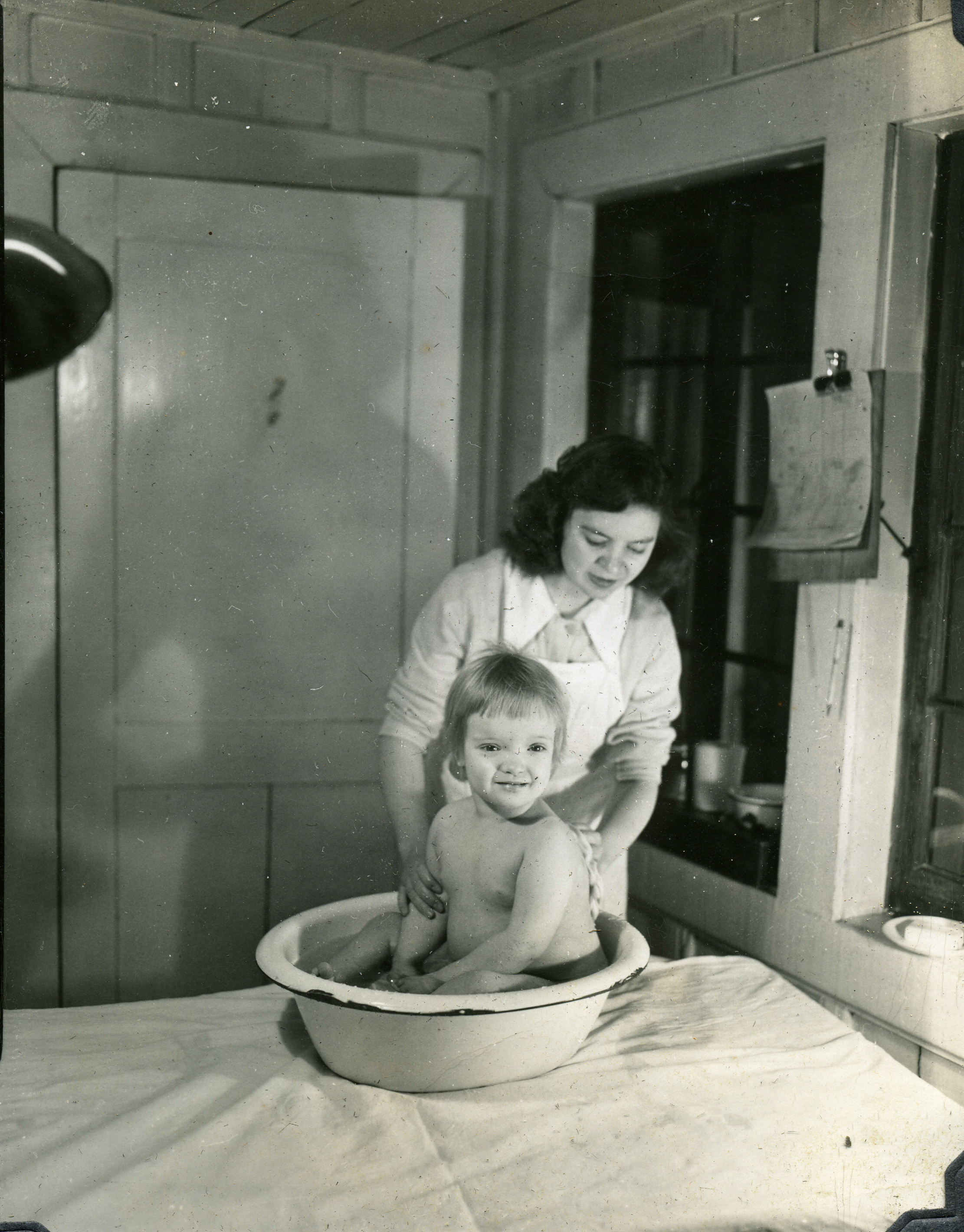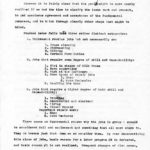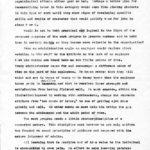Pine Mountain Settlement School
Series 13: EDUCATION
Work Program Critique
Anonymous, c. 1930s

Bathing child at infirmary. Grace Rood Album. [rood_085]
EDUCATION Work Program Critique
Anonymous, c.1930s
TAGS: Education work program, labor program, curriculum, student employment;, vocational training, comparing progressive educational with a work program, democratizing labor
In an undated document describing the work program at Pine Mountain Settlement School, c. 1930s, the anonymous author struggles to reconcile the progressive educational program of the School with a work program that seems to be out of step with the values of the general progressive education program. The author describes the work program as one with “… departmental friction and a muggy conception of what the program means.”
The author outlines what he believes to be the three underlying reasons for the creation of the work program at Pine Mountain Settlement School. They are as follows:
- To get the necessary tasks of the school community done efficiently as possible without hurt to the individual.
- To develop with the student wholesome attitudes toward manual labor and his employer.
- To effect a degree of operating economy for the school and to provide an honorable and self-respecting basis for the student’s acceptance of the school’s offering.
The author continues
We may differ as to the relative importance of the three but, in general, there is agreement on the basic nature of the three taken together. We might list several other related but secondary purposes of the work program such as
- To provide try-out vocational experiences
- Correlation of the academic experience with the manual
- a sharing of the unpleasant but necessary duties
- to pay one’s way at Pine Mountain
- to relate theory to practice, etc.
It would seem that not one of these and not even the five taken together would justify completely a program of student labor at Pine Mountain. However, each has its area of secondary importance when put in proper perspective with the three basic purposes. Teachers and supervisors tend to confuse the secondary and primary aims. This results in departmental friction and a muggy conception of what the program means.
If and when the three underlying reasons are accepted as valid there remains the problem of [the] method or the best means of realizing them as goals.
In the past five years much serious thought has been given to the work program resulting in an improved efficiency with less hours of labor for the student, a release of supervisory energy that is utilized in the formal teaching program and a general physical economy due to having the whole group doing the same thing at the same time.
However, it is fairly clear that the goals might be more nearly realized if we had the time to clarify the issue past and present, to get unanimous agreement and acceptance of the fundamental purposes, and to think through clearly other steps that might be tried.
Student labor falls into three rather distinct categories:
A. Unpleasant routine jobs but not necessarily so:
House cleaning
Dishwashing
Milking
Certain farm duties
B. Jobs that require some degree of skill and dependability:
Girl in charge of Milk House
Barn supervisor
Work at the Infirmary
Some types of repair jobs
Shop
Auto Mechanics
Handling the team
C. Jobs that require a higher degree of both skill and dependability:
Printing
Secretarial and clerical
Wiring
Diesel repair
Important repair work
Shop
Auto Mechanic
There seems no fundamental reason why the jobs in group A should be considered dull and unpleasant and something that all must share in. They do become just that when we so consider them. By over democratizing this class of jobs, [the] basic reason for a job program #2 is defeated, and basic reason #1 is not realized. Frequent changes of dish crews, milk crews, etc. tend to work an undue hardship on the supervisor and from an economic point of view are inefficient. This is aside from psychological effects either good or bad. Perhaps a better plan for democratizing labor in this category would come from placing students in this type of work until they show signs of developing specific skills and traits of character that would qualify them for jobs in class B or C.
Would it not be both practical and logical in the light of the proposed purposes of the work program to promote workmen and to hold them in certain depts [?] as they become more valuable to the organization?
From an administrative angle, an employer would deplore clock watching by his staff or the attitude on the part of an employee that his duties are bound between two finite points of time. Every administrator hopes for and encourages a different point of view on the part of his employees. He hopes rather that they will think and act in terms of tasks to be done; tasks that the employee takes pride in tackling and that he receives inner strength and satisfaction from having finished well. We must somehow, within the limitations impose by working with adolescents, change the students’ attitude from “two hours of labor,” to one of getting a job done quickly and well. In other words, we must help him bridge the gap between the adolescent and the adult point of view.
The work program needs a little sterner discipline of a concerted nature. This discipline must, however, be not only uniform but founded on sound principles of guidance and tempered with the mature judgment of adults.
All learning that is positive and of true value to the individual is accompanied by some pain. An effort to make learning painless has been the great misinterpretation of the progressive education method.
These thoughts have been set down only with the idea of having something tangible to start on in reorientating [sic] our thinking on the labor program.
While there appear to be agendas not shared by all the staff at the School in the author’s three-page discussion document, the paper points to the importance of the Work Program in the educational plan of the Settlement School. The Work Program was foundational to the early years of the institution.
GALLERY: EDUCATION Work Program Critique
- Anonymous. “Work Program at Pine Mountain.” p. 01. [work_prog__001.jpg]
- Anonymous. “Work Program at Pine Mountain.” p. 02. [work_prog__002.jpg]
- Anonymous. “Work Program at Pine Mountain.” p. 03. [work_prog__003.jpg]
- Anonymous. “Work Program at Pine Mountain.” p. 04. [work_prog__004.jpg]
See Also:
EDUCATION Curriculum Courses
EDUCATION Schedules
EDUCATION Term Paper Guidelines
Series 13: EDUCATION
Return To:
EDUCATIONAL PROGRAMS Guide





